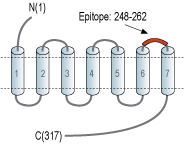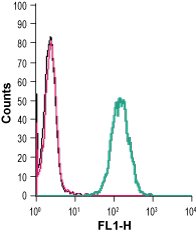Overview
- Peptide (C)RNVRIASRLDSWPQG, corresponding to amino acid residues 248-262 of rat GPR91/Succinate Receptor 1 (Accession Q6IYF9). 3rd extracellular loop.

 Western blot analysis of rat kidney membrane (lanes 1 and 3), mouse kidney lysate (lanes 2 and 4), mouse TK-1 T-cell lymphoma (lanes 5 and 8), mouse J774 macrophage cell (lanes 6 and 9) and human Jurkat acute T cell leukemia (lanes 7 and 10) lysates:1,2,5,6,7. Anti-GPR91 (SUCNR1) (extracellular) Antibody (#ASR-090) (1:200).
Western blot analysis of rat kidney membrane (lanes 1 and 3), mouse kidney lysate (lanes 2 and 4), mouse TK-1 T-cell lymphoma (lanes 5 and 8), mouse J774 macrophage cell (lanes 6 and 9) and human Jurkat acute T cell leukemia (lanes 7 and 10) lysates:1,2,5,6,7. Anti-GPR91 (SUCNR1) (extracellular) Antibody (#ASR-090) (1:200).
3,4,8,9,10. Anti-GPR91 (SUCNR1) (extracellular) Antibody, preincubated with GPR91/SUCNR1 (extracellular) Blocking Peptide (#BLP-SR090).
 Expression of GPR91 in mouse hippocampus.Immunohistochemical staining of perfusion-fixed frozen mouse brain sections with Anti-GPR91 (SUCNR1) (extracellular) Antibody (#ASR-090), (1:200), followed by goat anti-rabbit-AlexaFluor-488. A. GPR91 immunoreactivity (green) appears in neuronal profiles in the pyramidal layer (P, vertical arrow) and the stratum oriens (SO, horizontal arrow). B. Pre-incubation of the antibody with GPR91 (SUCNR1) (extracellular) Blocking Peptide (BLP-SR090), suppressed staining. Cell nuclei are stained with DAPI (blue).
Expression of GPR91 in mouse hippocampus.Immunohistochemical staining of perfusion-fixed frozen mouse brain sections with Anti-GPR91 (SUCNR1) (extracellular) Antibody (#ASR-090), (1:200), followed by goat anti-rabbit-AlexaFluor-488. A. GPR91 immunoreactivity (green) appears in neuronal profiles in the pyramidal layer (P, vertical arrow) and the stratum oriens (SO, horizontal arrow). B. Pre-incubation of the antibody with GPR91 (SUCNR1) (extracellular) Blocking Peptide (BLP-SR090), suppressed staining. Cell nuclei are stained with DAPI (blue).
- Lu, Y.T. et al. (2018) Cell Death Dis. 9, 672.
- Cherif, H. et al. (2018) PLoS Biol. 16, e2003619.
- Le, C.T. et al. (2018) PLoS One 13, e0192146.
GPR91 (Succinate Receptor 1), a member of the GPCR superfamily, is specifically activated by extracellular succinate outside the tricarboxylic acid cycle, resulting in activation of paracrine and endocrine effectors. Activation of GPR91 is associated with several diseases, including hypertension and diabetes1,2.
GPR91 was shown to regulate normal retinal vascularization, proliferative ischemic retinopathy and cortical revascularization post-ischemia. Activation of GPR91 influences different tissues such as kidney, heart, retina, white adipose tissue, and liver.
Through the activation of GPR91, succinate affects motility, migration, and growth of dendritic cells. In addition, the receptor directly promotes chemotaxis and potentiates activation initiated by Toll-like receptor agonists in dendritic cells1-3.
In the heart GPR91 mediates succinate-induced cardiomyocyte death. It was demonstrated that upholding levels of serum succinate can cause cardiac hypertrophy through the activation of the GPR911,2.
Application key:
Species reactivity key:
Anti-GPR91 (SUCNR1) (extracellular) Antibody (#ASR-090) is a highly specific antibody directed against an epitope of the rat protein. The antibody can be used in western blot and live cell flow cytometry. It has been designed to recognize GPR91 from rat, mouse, and human samples.

